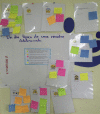Establishing content for a digital educational support group for new adolescent mothers in the Dominican Republic: a user-centered design approach
- PMID: 32857722
- PMCID: PMC7932007
- DOI: 10.1515/ijamh-2020-0054
Establishing content for a digital educational support group for new adolescent mothers in the Dominican Republic: a user-centered design approach
Abstract
Background: As digital interventions to improve health become widespread globally, it is critical to include target end-users in their design. This can help ensure interventions are maximally beneficial among intended populations.
Objectives: To generate the content of a digital educational support group, administered through WhatsApp, for new adolescent mothers and establish participants' cellular access and WhatsApp use.
Participants: Adolescent mothers with new babies.
Methods: We completed a two-phase user-centered design process. In phase I design sessions, participants discussed their postpartum experiences and completed an activity to elucidate their health and wellbeing information needs. In phase II sessions, participants individually identified which health information topics were important to them, then all topics were prioritized as a group. Phase II participants also completed a brief survey on cell phone access and WhatsApp use.
Results: Phase I included 24 participants, 21 of whom completed phase II. Priority health and wellbeing information topics in the postpartum period were identified as: child growth and development, understanding your baby, common childhood illnesses, breastfeeding, childhood nutrition, family planning, and self-care. Of phase II participants, 45% had cellular phone access and none had a data plan. Cellular service was inconsistently obtained with data packages or Wi-Fi. 30% of participants had no experience using WhatsApp.
Conclusions: Participants identified numerous health information needs, which will serve as the content for our planned digital support group and provides valuable insight for health care providers globally. Less than half of participants had consistent cellular phone access, and none had reliable access to cellular service.
Keywords: adolescent health; digital support group; mHealth; postpartum information needs; user-centered design.
© 2020 Walter de Gruyter GmbH, Berlin/Boston.
Conflict of interest statement
Figures



Similar articles
-
Digital Educational Support Groups Administered through WhatsApp Messenger Improve Health-Related Knowledge and Health Behaviors of New Adolescent Mothers in the Dominican Republic: A Multi-Method Study.Informatics (MDPI). 2020 Dec;7(4):51. doi: 10.3390/informatics7040051. Epub 2020 Nov 5. Informatics (MDPI). 2020. PMID: 33747831 Free PMC article.
-
Digital Health Needs and Preferences During Pregnancy and the Postpartum Period: Mixed Methods Study.JMIR Form Res. 2024 Jan 12;8:e48960. doi: 10.2196/48960. JMIR Form Res. 2024. PMID: 38214971 Free PMC article.
-
Perceptions and Attitudes Toward Mobile Health in Development of an Exclusive Breastfeeding Tool: Focus Group Study With Caregivers and Health Promoters in the Dominican Republic.JMIR Pediatr Parent. 2020 Aug 21;3(2):e20312. doi: 10.2196/20312. JMIR Pediatr Parent. 2020. PMID: 32821063 Free PMC article.
-
User Requirements for Comanaged Digital Health and Care: Review.J Med Internet Res. 2022 Jun 10;24(6):e35337. doi: 10.2196/35337. J Med Internet Res. 2022. PMID: 35687379 Free PMC article. Review.
-
Impact of mobile health interventions during the perinatal period on maternal psychosocial outcomes: a systematic review.JBI Evid Synth. 2020 Jan;18(1):30-55. doi: 10.11124/JBISRIR-D-19-00191. JBI Evid Synth. 2020. PMID: 31972680
Cited by
-
Mixed method evaluation of a clinic waiting room-based health education program in the Dominican Republic.Health Educ Res. 2023 Mar 23;38(2):177-191. doi: 10.1093/her/cyad001. Health Educ Res. 2023. PMID: 36715740 Free PMC article.
-
Experiences of social support and the role of engagement in a digital educational support group for adolescent mothers' health in the Dominican Republic.PLOS Digit Health. 2025 Apr 21;4(4):e0000808. doi: 10.1371/journal.pdig.0000808. eCollection 2025 Apr. PLOS Digit Health. 2025. PMID: 40258038 Free PMC article.
-
Digital Educational Support Groups Administered through WhatsApp Messenger Improve Health-Related Knowledge and Health Behaviors of New Adolescent Mothers in the Dominican Republic: A Multi-Method Study.Informatics (MDPI). 2020 Dec;7(4):51. doi: 10.3390/informatics7040051. Epub 2020 Nov 5. Informatics (MDPI). 2020. PMID: 33747831 Free PMC article.
-
A randomized controlled trial of the dissemination of an mHealth intervention for improving health outcomes: the WiseApp for Spanish-speakers living with HIV study protocol.BMC Public Health. 2024 Jan 17;24(1):201. doi: 10.1186/s12889-023-17538-y. BMC Public Health. 2024. PMID: 38233908 Free PMC article.
References
Grants and funding
LinkOut - more resources
Full Text Sources
Research Materials
